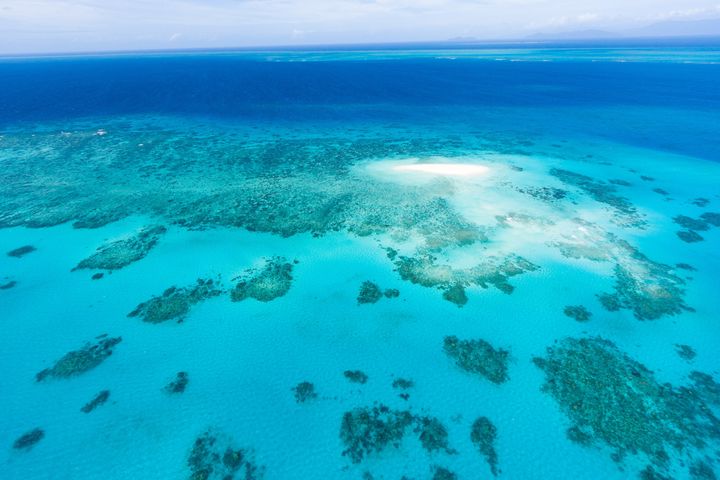
Lying facedown in the water, my mask slightly foggy and the snorkel bobbing above my head, I am looking for fish. I'm somewhere out on the Great Barrier Reef, having flown out there from Hayman Island, a private resort in the Whitsunday islands. The trip took about 45 minutes on a six-seater de Haviland seaplane, and then we all debarked onto a launch from which we dove into the warm water.
The view from the air was magnificent. The Great Barrier Reef, really a series of reefs stretching out for 1,600 miles along the northern edge of Queensland, Australia, is the largest coral reef system in the world, and it looks like an endless series of lovely aqua lily pads. But they are all underwater, so the effect was slightly wavy. It's one of the seven natural wonders of the world and mesmerizing.
In the water, I calm my breathing down and begin to look around. I am struck by how different the coral looks from underwater. It's dullish, almost gray. I don't know what I expected, but it comes as a surprise that it's not what I've seen in all those movies that make it look like a multicolored wonderland.
And then it happens.
A school of tiny fish swims by. They are brilliantly-colored -- green, yellow, black, all beautiful. I try to reach out and touch one but with no luck. The distances in the water are distorted through the mask. My hand can't quite get there. And it's just as well. Better they are left undisturbed, to watch and wonder at, rather than touch.
A year ago, this area was devastated by two massive cyclones that arrived only four days apart. Large areas of inland Queensland were heavily flooded. The 74 islands that make up the Whitsundays were impacted to varying degrees, with Hayman being one of the worst hit. Hayman is a small private island of 988 acres or about the size of New York's Central Park. It's been described as a "once-before-I-die" destination for Australians, and it's become popular for dream vacations and weddings.
When the cyclones hit, they destroyed a huge, multimillion dollar renovation of Hayman that had been had been underway since the year before, in 2010. The storm surge threw sand everywhere, into the rooms, onto the roof tops and in the pools, while branches from the trees became dangerous projectiles. The winds were clocked at upwards of 180 miles per hour with some gusts even higher.
So the question for Hayman was this: Keep guests on the property while making repairs or close it down and completely redo it. The decision was the latter, and for five months in 2011, Hayman, one of only four of Leading Hotels of the World in Australia, closed down completely and rebuilt.
Today, it's a wonder. All the rooms have been renovated, the pools have been rebuilt and the new restaurants, Azure and Fontaine, are open, with one open to the beach outside, the other overlooking a pond with white swans. In addition, Hayman has built eight new super-luxury Beach Villas designed by tropical resort architect Kerry Hill. Entering from a garden path, you first walk into the over-sized bathroom, then around an indoor plunge pool and then into the spacious bedroom, with the white sandy beach a step outside. For privacy, you are well-advised to pull down the electronic sheer blinds during the day and the opaque blinds at night, although awakening to dawn is breathtaking.
The gardens, which were decimated by the cyclones, have been rebuilt to the tune of $4 million with the planting of 33,000 new plants from 320 species, all done by Australian television celebrity and gardener Jamie Durie. The lovely white cockatoos have also returned, populating the trees outside.
"All of the buildings have been repainted," said Hayman managing director Lloyd Donaldson at the reopening. "The new beach villas have been completed and all of the sandstone has been rejuvenated. We've upgraded all our lagoon rooms, our penthouse and the majority of our guest rooms have been refurbished. Pretty much everything on the island has been touched."
The island has a rich and colorful history. In the 1930s it was a refuge for fisherman, with only cabins and the most rudimentary of amenities. American novelist Zane Grey arrived in 1936 and filmed "White Death" on the island; with that kind of notoriety, a resort soon replaced the cabins.
Then, in 1947, Reg Ansett, who owned an airline, bought the island and turned it into a destination for international game fishing enthusiasts, who arrived by coastal steamer. He reportedly paid £14,000, or £10 for every wild goat then living on the island. It's gone through several owners since then, having been hit by several cyclones in the past, including one in 1970 that also destroyed the property.
We arrived at Hayman from Hamilton Island, about an hour's plane ride from Brisbane and two hours from Sydney. From Hamilton, you can take one of Hayman's sleek luxury launches for a fast 55-minute ride to the resort; canapés and Champagne come with the trip, as well as onboard check-in.
One there, you are ensconced in a five-star resort that is also a world-class water sports center. There are 400 employees for a maximum of 450 guests in 210 rooms. The property is spread out along the beachfront, with less clutter and cleaner lines after the rebuilding. As someone once noted, even the two-person pods around the main pool resemble business class airline seats. The property is also family-friendly, with special provisions for children's activities.
But for the grownups, the "piece de resistance" is a trip by seaplane out to the Great Barrier Reef itself and the chance to dive or snorkel. I didn't get to touch a fish, but I did get to a chance to say that I went swimming, face down, on Australia's Great Barrier Reef. And somehow that's enough.